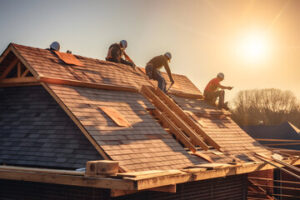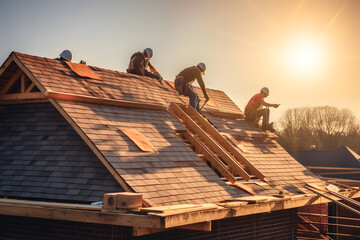Your roof is a big investment that protects your home from the elements. Damaged shingles, tiles, and other roofing materials can let water in, leading to ceiling and wall damage.
You should always get any leaks repaired immediately. But determining whether to repair or replace will depend on your budget and long-term goals. Contact Roof Repair Las Vegas Nevada for professional help.
Shingles and other roofing materials are highly durable and able to withstand a lot of wear and tear, but that doesn’t mean they’re infallible. High winds, falling debris, and even natural occurrences like aging can damage shingles and lead to roof leaks. Damaged shingles are one of the most common signs that a roof is in need of repair, so you should always be on the lookout for these problems.
One of the most obvious signs that a shingle is damaged is the presence of water stains or leaking in your home’s interior. However, you can also tell by noticing cracks or breaks in the shingles themselves, or seeing a build-up of granules (which protect shingles) in your gutters and downspouts.
If you notice any of these symptoms, you should climb onto your roof to inspect the condition of your shingles. To do so, be sure to wear safety equipment including gloves, protective eyewear, and a sturdy ladder. Also, be sure to inspect your shingle flashing, which is usually metal and directs water away from a chimney or other structures on your roof.
Once you’ve inspected the shingles, you should be able to determine if they need to be replaced or repaired. If you decide to replace them, make sure to choose shingles that are similar in color and style to your existing ones. Ensure that you have enough roofing nails to secure the new shingles. If you need to remove a shingle, start by loosening the roofing nail that’s holding it in place with a pry bar. Then, gently lift the shingle and pull it from the roof, being careful not to break or damage the surface underneath.
If a shingle is torn, try using a piece of tar paper to seal it. You can also use a caulking gun to apply roof cement to any worn or cracked areas. You should also consider contacting your shingle manufacturer about any issues that you’ve encountered, as these may be covered under your warranty. Also, be sure to check out our insurance-focused resources and webinars, where you’ll find tips about property, perils, and trends impacting claims nationwide.
Leaks
A roof leak is a serious problem that can lead to water damage in the interior of the home. If left untreated, a small leak can balloon into a major problem that may require a re-roofing or structural repair. The key to preventing leaks is regular inspections and prompt repairs.
A common leak source is a loose or cracked asphalt shingle, but other problems can cause leaks as well. Damaged gutter systems, old flashing, chimneys and vents, skylights, and corroded metal can all allow water to seep through the roof. To prevent leaks, regularly inspect these areas for water stains or black marks on the ceiling and walls, or for soft or sagging spots in the roof surface.
When a leak is discovered, it’s important to take immediate action. Some homeowners make the mistake of attempting to do a “band-aid” repair, but this can cause more problems than it solves. This type of quick fix can also void any warranty on the roof and may destroy evidence that could help determine who is responsible for the leaks.
The best way to identify a leak is to check for water stains or dark marks on the ceiling. Then, look in the attic or crawl space to find the source of the leak. A water test can also be helpful. Spray a section of the roof with a garden hose while someone inside watches for signs of water penetration, such as a drip or dampness.
For a temporary solution, you can try to apply roofing tape or use a roof patch kit to seal the leak from the inside. However, you should always have a professional inspect the roof and make any necessary repairs to prevent further damage to the structure of the house.
Regular maintenance, inspections and repairs can keep minor issues from becoming major problems that need a re-roofing. In addition, keeping the roof free of debris can reduce the risk of leaks and other problems. Inspect the roof and the surrounding area frequently, especially after severe weather events. Remove any leaves, sticks or other debris that can collect and clog drains or cause pooling water.
Sagging
Your roof protects your home from weather damage and helps keep your family safe and comfortable. Like any other part of your house, it’s susceptible to wear and tear over time and needs regular maintenance and repair to prevent serious structural issues from developing. Detecting early signs of wear can help you avoid costly repairs in the future and extend the life of your roof. Common signs of roof damage include missing shingles, water stains on interior walls and ceilings, and structural damage such as sagging or warping.
If you notice any of these signs, it’s important to get them repaired right away to avoid further deterioration and expensive repair costs. Often, these problems can be fixed by professional roofing contractors and are relatively inexpensive. A full roof replacement is typically only necessary if the entire structure is damaged or if there are multiple leaks.
Generally, minor roof repairs take one to five hours to complete. Replacing a single shingle, repairing chimney flashing and fixing gutters are all simple, quick fixes. However, more complex roof repairs such as repairing leaks, sagging or improving ventilation can take several days to finish.
Leaky cracks in the shingles can be repaired with roof sealant. If you notice a crack, use a caulking gun to apply a bead of sealant inside the crack. After letting the sealant dry, use a putty knife to smooth over the area and cover the crack. Make sure to match the color of your existing shingles when doing this repair.
Another common leak source is damaged or cracked flashing. This is the thin metal sleeve that wraps around pipes, vents and other protruding parts of your roof. Flashing is designed to be durable and resistant to moisture, but it can still leak over time if it’s not properly installed or maintained.
If you’re noticing leaking flashing, start by tracing the spot in your attic to find the leak. This will usually be a dark stain in the ceiling, or a trail of damp and moldy insulation. After locating the spot, you’ll need to trace back outside to find the source of the leak. You may need to remove or replace the flashing, which can be difficult and dangerous if it’s attached to a pipe.
Damaged Flashing
Flashing is the thin strip of metal that helps prevent leaks around roof penetrations like chimneys, vents, and skylights. The flashing carries water safely over any gaps and channels it toward the gutters. But like other parts of the roof, flashing is vulnerable to damage from weather and aging. Inspecting the flashing periodically is a good way to protect the roofing materials beneath it.
Flashing deterioration is caused by moisture and exposure to sunlight. Over time, these factors can cause the flashing to bend, warp, or rust, which weakens it and leaves it susceptible to leaks. When a flashing section is damaged, it should be repaired immediately to avoid the potential for water intrusion into the roofing system and the interior of the home.
Checking the flashing for visible signs of deterioration is a great way to determine when it is time for repairs or replacement. Look for cracks, rust spots, and other indications of deterioration, especially around the edges where it meets other materials. You should also look for loose sections of the flashing or a gap where it meets the roofing materials. Water stains on the ceiling and walls inside the home are another indicator that flashing is leaking or damaged.
When inspecting the flashing, make sure to wear appropriate safety gear, including sturdy work boots and a ladder in good condition. Also, ensure that a qualified professional is available to perform the repair work when necessary. A roofing contractor can help with the inspection and provide recommendations for any needed repairs.
If the flashing is leaking or showing signs of deterioration, a temporary solution is to apply roofing cement or flashing tape to seal the cracks or holes. This will provide some protection from a rainstorm, but should be followed up by a professional repair to ensure that the problem is fixed for good.
It’s also important to trim back overhanging branches from nearby trees, which can scrape or damage the roof during windy conditions. If these problems are not addressed, they can result in leaks and even billowing, a condition that can rip off part or all of the roof. Hiring a professional roofing contractor can help address these issues quickly and provide a long-term solution to protect the roof and interior of the home.

